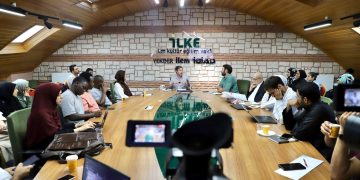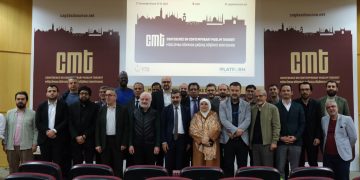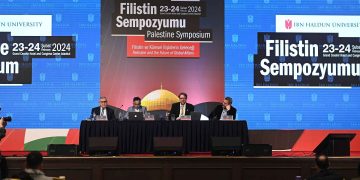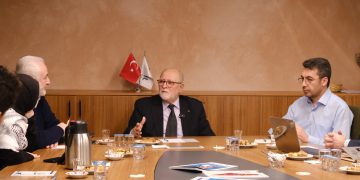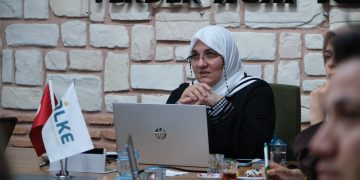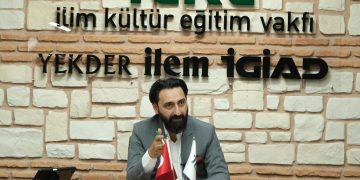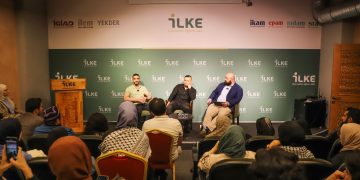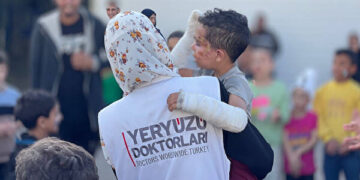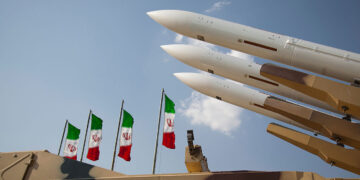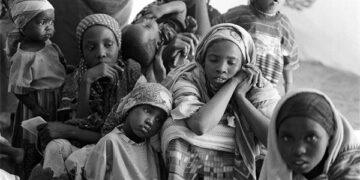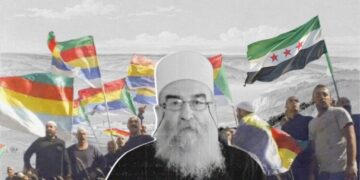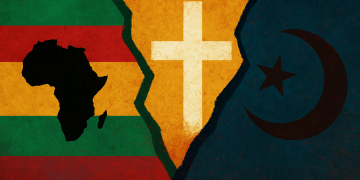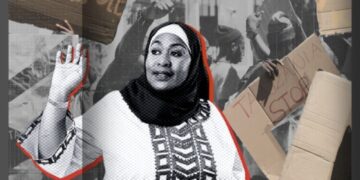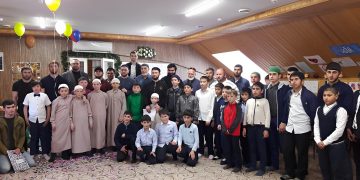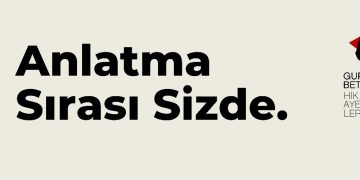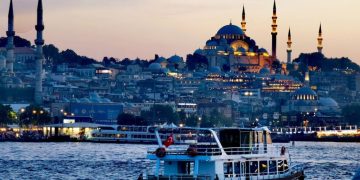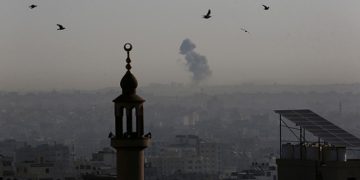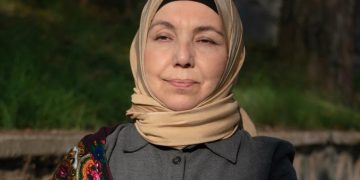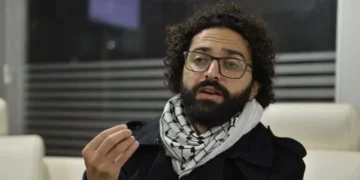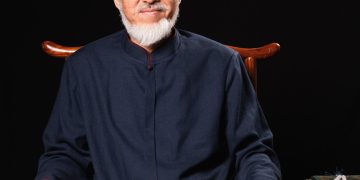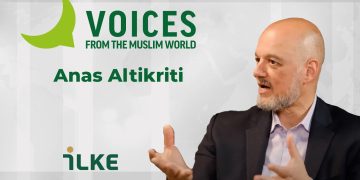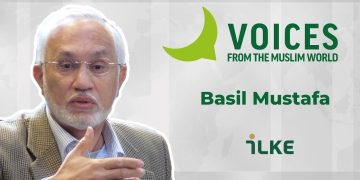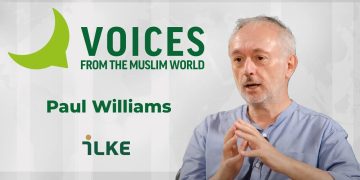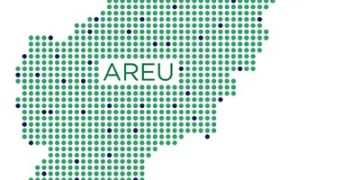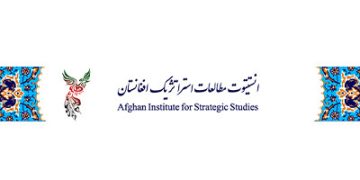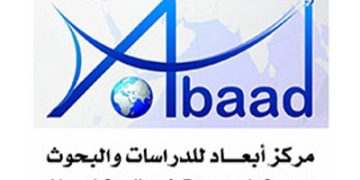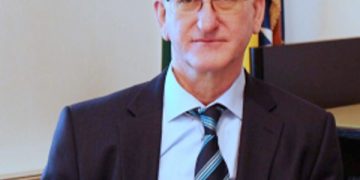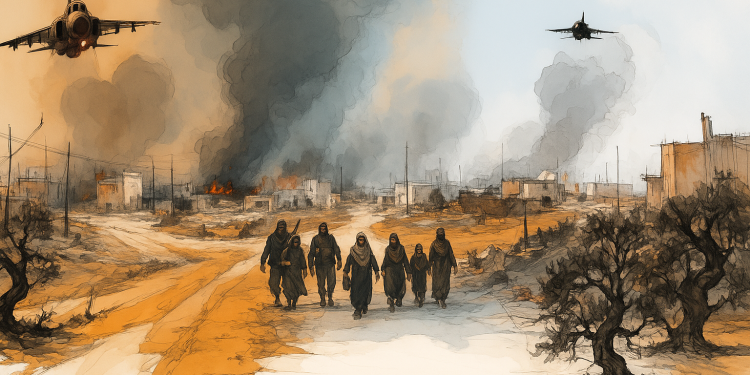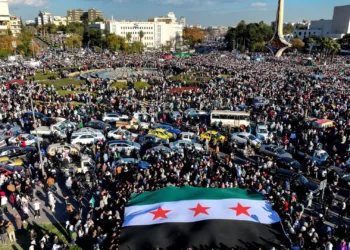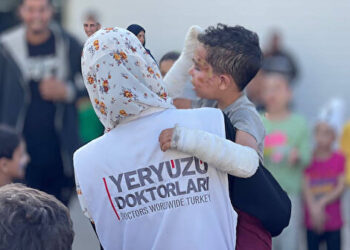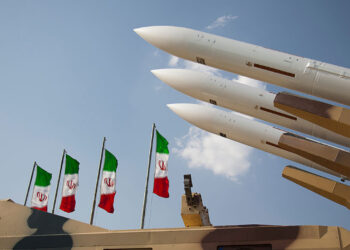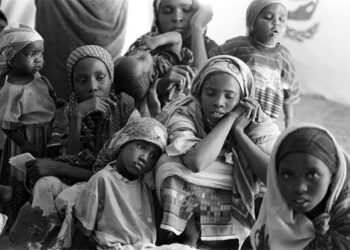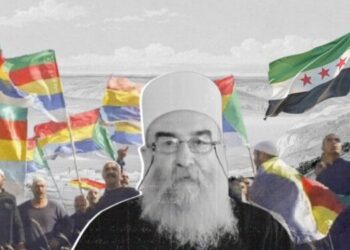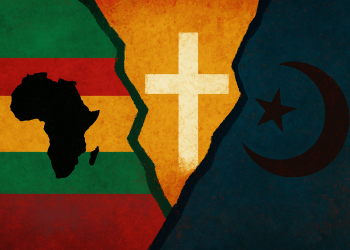*This analysis is written by Zaynab Nemr, and Rami Zurayk.
Introduction: Environmental warfare as a colonial strategy
Since October 2023, the borderlands of South Lebanon have been burning. Olive groves, oak forests, and tobacco fields that once defined the agrarian life of Jabal ʿĀmil have been repeatedly set ablaze by Israeli munitions—some carrying white phosphorus—leaving behind blackened slopes and poisoned soil. The devastation is not random. It follows a visible pattern of systematic environmental assault aimed at severing the relationship between people and their land.
What has unfolded in South Lebanon over the past year is not simply a humanitarian crisis. It is, as many local researchers and international observers now describe it, ecocide: the deliberate destruction of the ecological conditions that make life possible.
This paper argues that Israel’s ongoing military operations across South Lebanon, Gaza, and the West Bank form part of a regional ecocide—a coordinated destruction of ecosystems, food systems, and human settlements designed to remake the geography of the region. The forms differ, but the logic is one: to depopulate, redesign, and recolonize. Ecocide here functions not only as environmental devastation but as an instrument of control, extending the long history of settler-colonial strategies that have targeted land as both resource and adversary.
The implications of this environmental warfare extend far beyond military strategy. A scorched-earth policy seeks not only to defeat an enemy but to render the land itself incapable of sustaining life—thereby preventing return. In both Lebanon and the West Bank, as well as Gaza, the objective is to transform fertile agrarian zones into empty corridors that can be fenced, monitored, or resettled.
A century-long geography of dispossession
The violence against land in South Lebanon cannot be understood in isolation. It is the latest chapter in a century-long geography of dispossession that has linked Lebanon’s southern hills to Palestine’s northern valleys. The loss of land and natural resources in South Lebanon did not begin in 1982 or 2006—it is part of a longer historical process that traces back to the late nineteenth century, when Zionist colonization in Palestine started to transform the agrarian landscape of the border region between Galilee and Jabal ʿĀmil (South Lebanon).
- The Late Ottoman Period (1880s–1918): Land Sales and Border Ambiguity
During the final decades of Ottoman rule, Zionist organizations such as the Jewish Colonization Association (JCA) and private European investors began purchasing large estates in northern Palestine, particularly in the districts of Safad and Acre.
At that time, the Ottoman administrative boundary between Palestine and the Lebanese Mutessarifate was unclear, and many Shiʿa farming families from Jabal ʿĀmil cultivated land that straddled what would later become the international border.
As historian Kamal Salibi notes in A House of Many Mansions (1988), “ownership titles and village boundaries were often fluid between the Galilee and South Lebanon, enabling early Zionist buyers to claim lands traditionally farmed by Lebanese villagers.” This early colonial cartography blurred agrarian identities, embedding dispossession within geography itself.
- The Colonial Border and the Loss of the “Seven Shiʿa Villages” (1920–1923)
The most precise instance of Lebanese land loss came after World War I, when France and Britain drew the 1920–1923 boundary between Lebanon and Palestine.
Seven predominantly Shiʿa villages—Tarbikha, Saliha, Malkiyeh, Nabi Yushaʿ, Qadas, Hunin, and Abil al-Qamh—were transferred from French-administered Lebanon to British-controlled Palestine. France accepted the transfer in exchange for British economic concessions.
Historian Laura Robson explains that “the redrawing of the border was part of a colonial negotiation over trade and oil, not national identity” (Colonialism and Christianity in Mandate Palestine, 2011).
The inhabitants of these villages remained Lebanese in practice—they paid taxes to Beirut and sent their children to schools in Tyre and Bint Jbeil—until the Nakba of 1948, when they were expelled by Israeli forces and their lands absorbed into the Israeli land control.
As historian Ahmad Beydoun writes, “The loss of the Seven Villages was the first dismemberment of South Lebanon—a quiet annexation that cut Jabal ʿĀmil off from its southern lands”[1].
- The Nakba (1948) and Its Spillover into Lebanon
The Nakba of 1948 resulted in the depopulation of over 400 Palestinian villages and the flight of more than 100,000 refugees into Lebanon (UNRWA). Many came from Galilee, only a few kilometers from the border.
The Israeli occupation army destroyed or absorbed the Seven Shiʿa villages, confiscated their lands under the 1950 Absentees’ Property Law, and expanded settlements such as Avivim and Al Malkiyeh over them.
The descendants of these Lebanese-origin villagers reside today in Tyre, Bint Jbeil, and Beirut, still holding Ottoman and French land deeds that prove ownership of plots north of the current border.
- The Ecological and Hydrological Dimension
From the 1950s onward, Israel has sought to control water sources feeding the Jordan River from Lebanese territory, particularly the Hasbani and Wazzani rivers.
The 1955 Johnston negotiations and subsequent Israeli diversion plans explicitly included “the utilization of Lebanese tributaries of the Jordan. This established the precedent for later disputes over Wazzani water use during and after Israel’s occupation of South Lebanon.
By manipulating river flows and aquifers, Israel extended territorial control into the ecological sphere—turning water into a transboundary weapon (UNIP,2007).
- Cumulative Effect
Taken together, these episodes—the land purchases and boundary shifts of the 1880s–1920s, the loss of the Seven Shiʿa Villages, the Nakba’s expulsions, and the long-term hydrological control projects—form a century-long continuum of territorial and ecological encroachment.
Each stage progressively redefined the Lebanese–Palestinian frontier, transforming it from a porous agrarian zone of shared livelihoods into a militarized border designed to isolate southern Lebanese communities from their historical lands, kin, and water sources.
As one farmer from Bent Jbeil recalled: “Our olive trees used to face their cousins across the valley—now there is a fence, and our cousins are refugees.”
This historical layering reveals the persistence of a colonial logic that merges territorial conquest with environmental manipulation. Whether through the redrawing of borders, diversion of rivers, or militarization of farmland, the same rationale endures: to control water, soil, and movement as a means of managing people.
From occupation to ecological annihilation: The Transformation of Environmental Warfare in South Lebanon
Historically, Israel’s control over South Lebanon (1982–2000) relied on using time as a weapon and space as a mechanism of control, much like what we observe today in the West Bank—rather than through direct destruction of nature by burning trees or bombing orchards. Farmers were cut off from their groves by checkpoints, curfews, and restricted zones near the so-called security belt; access to irrigation and pastures was regulated through military permits or allied militias.
While Israel did not wage an open campaign to burn land as it does today, it systematically appropriated, polluted, and controlled natural resources—especially water and fertile farmland—as part of its occupation infrastructure.
Israel seized and militarized large tracts of agricultural land inside what it called the security zone, extending up to 15–20 km northward from the border. Many of these lands were fenced off or mined, cutting thousands of farmers off from their olive groves and tobacco fields for years. This broke the rhythm of agrarian life—planting, harvesting, irrigation—all interrupted not by fire, but by bureaucratic and military obstacles. As my mother once said, “The occupation controlled not only the movement of people, but of time—the time of planting, of pruning, of harvesting.”
In this way, Israel’s policy transformed daily agricultural life into a form of slow violence (Nixon 2011): the erosion of livelihoods without necessarily destroying the landscape, but through exhaustion and delay. Olive and tobacco production declined, terraces collapsed, and pastures degraded. Local testimonies from Aytaroun and Houla recall that “farming became an act of resistance,” as people risked being shot for entering their own fields near the occupied border.
Water resources were also appropriated—particularly from the Wazzani Springs, which feed the upper Hasbani River, one of the three main tributaries of the Jordan. During the occupation, Israel diverted Wazzani water to supply nearby settlements and outposts inside the security belt. According to reports from Middle East Economic Digest and Al Jazeera (2002), the Wazzani wells were connected to Israeli pipelines, and pumping continued even after Israel’s withdrawal, prompting a major regional dispute over “Israel’s illegal use of Lebanon’s groundwater resources.”
Lebanon’s Ministry of Energy estimated that this diversion depleted local water tables and reduced irrigation flows for villages such as Blida, Kfar Kila, Ainata, Bint Jbeil, and Aytaroun.
When Israel withdrew in May 2000, it left behind tens of thousands of anti-personnel landmines scattered across agricultural valleys and forests—”More than 3,843 persons in Lebanon since 1975 have been killed and maimed, with 898 killed and 2,945 people. Between August 2006 and June 2011, cluster munitions alone killed and maimed more than 407 people; 49 were killed and 358 were injured, including children less than 12 years old (10%), adolescents between 13 and 18 years of age (19%), and adults aged 19 years and above (71%). Women account for 6% of the victims of cluster munitions in Lebanon, according to the Lebanese Mine Action Centre (LMAC) surveys. These mines continue to restrict access to farmland and have caused hundreds of civilian casualties. UNEP’s Post-Conflict Environmental Assessment (2007) confirmed that these contaminated zones severely restrict or prohibit access to agricultural land for long periods of time.
The environmental toll mirrors earlier moments in Lebanon’s war history. After the 2006 war, the United Nations Environment Program (UNEP 2007) documented a similar pattern of deliberate ecological damage, including the Jiyeh power-plant oil spill— “the worst environmental disaster in Lebanon’s history”—and widespread contamination from cluster munitions that rendered farmland inaccessible for more than a decade. As UNEP reported, “The large number of cluster bombs with a low detonation rate remains an issue of serious concern … agricultural areas and natural reserves are heavily contaminated.”
What has changed since October 2023 is the intensity and directness of the targeting. Instead of merely restricting farmers’ access, the strategy now focuses on physically erasing the ecological base itself—by burning orchards, poisoning soil, and depopulating villages through continuous airstrikes. As one farmer in Aita al-Chaab said in May 2024, “Before, they stopped us from reaching the trees. Now they burn the trees so there is nothing left to reach.”
While the goal remains the same—to disconnect people from their land—the means have escalated from control to annihilation: not only killing the land, but killing those who care for it. Several farmers were killed during the olive harvest season, as happened in Sinay, where Dr. Rami Zurayk’s uncle was killed while picking olives. These acts carry a devastating symbolic weight: they strike at the heart of rural life, where harvesting is both economic and cultural.
Beyond the killing of individuals, Israel has also engaged in the appropriation of the landscape itself. Local municipalities in Aytaroun, Meiss al-Jabal, and Deir Mimas have documented cases of ancient olive trees—some over 500 years old—being uprooted and transported across the border into Palestine. Though smaller in scale than the burning campaigns, this act encapsulates the logic of colonial environmentalism: erasing local ecological identity and replanting it elsewhere under another sovereignty. As one resident remarked, “They even steal our trees to make their land look old.”
The present war thus represents a qualitative shift: the policy has moved from control to erasure—from restricting access to obliterating the ecological base itself. The method has changed from bureaucratic occupation to ecological annihilation. It is no longer about controlling the tempo of farming; it is about removing the very possibility of farming altogether.
Ecocide in South Lebanon (2023–2025)
The environmental destruction unfolding in South Lebanon since October 2023 represents the most extensive assault on the region’s ecosystems since the 2006 war. Following the work of the research team on ecosystem contamination due to Israeli war since November 2023 with Dr. Rami Zurayk, and the local municipalities of Ainata, Aytaroun, and Bint Jbeil, we’ve documented a systematic environmental assault: forests and orchards deliberately bombed, soils contaminated, and farmlands repeatedly ignited to sever the relationship between people and their land.
According to the American University of Beirut’s Faculty of Agricultural and Food Sciences (AUB–FAFS, 2024), over 10,800 hectares of land burned in 2024 alone— “an area four times the size of Beirut and ten times the annual average.” The fires were not spontaneous. They followed a deliberate pattern of incendiary attacks documented by local municipalities and verified through satellite analysis, remote sensing, and ground-level videos collected by residents.
The Food and Agriculture Organization (FAO, 2025) provides the most comprehensive estimate of the agricultural losses. In its Agricultural Damage and Loss Assessment, the organization reported that “the agriculture sector sustained USD 118 million in damages and USD 586 million in losses,” noting that “the Nabatieh and South governorates suffered the heaviest impact, with 2,154 hectares of fruit orchards burned—814 ha of olive, 637 ha of citrus, and 461 ha of banana.” These figures confirm what farmers and municipal officials have described since late 2023: that Israel’s air campaign has systematically targeted the ecological foundation of rural livelihoods.
In early October 2025, Israeli airstrikes ignited the Ali al-Taher forest near Nabatieh, destroying dense woodlands and olive groves despite international warnings. Satellite imagery captured the spread of the blaze over several kilometers, with smoke visible from the Mediterranean coast. This and similar incidents in Houla, Aytaroun, and Deir Mimas reinforce a continuing pattern of environmental destruction that extends well beyond military targets.
This ongoing ecocide. It is the intentional targeting of nature as a weapon: to burn the trees, poison the soil, and empty the villages. As we say in our fieldwork, “They make the land unlivable so they can later say it was empty — no nature, no people.”
White Phosphorus as Environmental Warfare
Human Rights Watch confirmed in October 2023 that Israel had used white phosphorus munitions in at least seventeen municipalities, including Aita al-Chaab, Markaba, and Dhayra, areas dominated by orchards and olive terraces (Human Rights Watch, 2023).
Reuters, citing data from Lebanon’s National Council for Scientific Research (CNRS–L), reported “about 175 white phosphorus attacks affecting more than 600 hectares of cropland” during the first six months of the war. These findings were corroborated by environmental researcher Ahmad Baydoun (WhitePhosphorus.info) using geolocated videos and photos from villagers’ phones, cross-checked with satellite imagery that captured burn scars radiating outward from phosphorus impact points.
Israel argues that these munitions are used for smoke or target marking and that the burning is incidental to operations against Hezbollah. However, based on what we have seen on the ground, on social-media videos recorded by villagers, and on our own spatial and agricultural knowledge of the area, this claim does not hold. Many of the burn sites we have documented and compared through satellite imagery are far from any visible military infrastructure. They spread across orchards, grazing lands, and forested hills, destroying places that have no military value but deep ecological and cultural meaning for the communities. So, “most of the sites hit by white phosphorus were civilian farmlands and forests, not active combat zones”. Taken together, the scale, the geographic distribution, and the continuing nature of these attacks show that this is not an accident of war. It reflects a deliberate environmental strategy—to create an emptied, uninhabitable buffer zone and to break the socio-ecological bond that ties people to their land.
This pattern suggests an intentional strategy of environmental warfare: targeting the land itself as a means of depopulation and territorial sterilization. The phosphorus bombardments are not only destructive in the moment; they render the soil toxic and unproductive for years, undermining any possibility of agricultural recovery.
Beyond Borders: Ecological Warfare in Palestine
The current war extends a long-standing colonial logic that treats the environment itself as a battlefield. From Palestine to South Lebanon, the same model of domination unfolds in different intensities and forms: to make the land unlivable, unproductive, and ultimately uninhabited.
In Gaza, environmental destruction and human extermination converge into one process. According to the Food and Agriculture Organization (FAO, 2024), more than 80 percent of Gaza’s cropland and nearly all irrigation infrastructure have been obliterated, producing what can only be described as genocide through landscape annihilation. The goal is to erase both the population and its ecology, rebuilding a new geography “above the massacres and the blood.”
Israel’s destruction of Gaza’s agricultural base is not incidental; it follows a deliberate logic of environmental erasure. Entire neighborhoods have been leveled, orchards bulldozed, and groundwater poisoned.
The FAO, 2024 assessments confirm that nearly all wastewater treatment and irrigation systems have been rendered inoperative, turning arable lands into toxic, dust-choked ruins. The objective is clear: to eliminate Gaza’s existing ecology—both human and natural—and rebuild another landscape over the rubble, with new settlements rising atop the massacres and the memory of those erased. It is the transformation of a once-living environment into a controllable desert.
In the West Bank, the process is slower but no less systematic. Through collaboration with the Applied Research Institute–Jerusalem (ARIJ), our team analyzed satellite imagery from Bethlehem Governorate (1970–2021) showing how agricultural and pasture lands have been systematically converted into settlement infrastructure—roads, industrial zones, and suburban sprawl. What appears as “development” is, in reality, ecological colonization: the use of cultivation and concrete alike to extend territorial control. The time-series analysis demonstrates that large expanses of agricultural land have been absorbed by settlement growth. At the same time, settlers continue to uproot trees and restrict grazing, transforming once-continuous rural landscapes into fragmented “islands” of survival. As our forthcoming paper shows, this transformation is not accidental but follows a clear colonial pattern: ecological domination as territorial annexation.
Across the geography, the strategy is both material and symbolic:
To destroy the land that sustains resistance, to erase the cultural and ecological continuity of Arab rural life, and to replace it with a controlled, engineered environment designed for domination, not coexistence.
The Land Resists: Agrarian Defiance and the Ethics of Replanting
Yet, as every farmer in the South will say, the land itself resists. Replanting an olive tree after a bombing is more than recovery—it is an act of defiance, a reaffirmation of existence. As villagers often put it, “We plant to resist, not simply to eat.”
This conviction lies at the heart of the argument that follows. It traces the continuum of environmental violence from the late nineteenth century to the present and situates contemporary destruction within a regional framework of settler-colonial ecocide. By weaving together historical analysis, environmental data, and local testimony, it argues that the struggle for justice in Lebanon and Palestine is inseparable from the struggle for the life of the land itself.
A scorched-earth policy, in this sense, aims to destroy not only the enemy’s capacity to fight but the land’s ability to sustain life. In South Lebanon, Gaza, and the West Bank, it goes far beyond demilitarization—it is about erasing the ecological foundation of return. The goal is twofold: to depopulate and to redesign. By burning orchards, bombing wells, and leveling cropland, Israel renders these regions unlivable—pushing people away and creating empty buffer zones.
In Gaza, this means annihilating both people and nature to rebuild a controlled geography atop the ruins. In South Lebanon, it means carving a burned corridor along the border, echoing the logic of the old “security belt.”
The purpose, therefore, is not merely military—it is colonial and spatial: to transform vibrant agrarian landscapes into blank, governable terrain.
In short, scorched earth is not about defeating resistance; it is about defeating the land itself. And for this reason, resistance becomes agrarian. Each act of cultivation becomes a political act; each olive tree planted after fire and bombardment asserts a moral claim to continuity, memory, and hope. As one farmer from Aytaroun put it, “The trees return before we do.” To destroy the land, then, is to wage war not only on nature but on the possibility of belonging. And to cultivate it again—against all odds—is to reclaim both the soil and the self.
References:
AUB-FAFS. The 2024 Israeli War on Lebanon: A Devastating Blow to Agriculture and the Environment. Beirut: Faculty of Agricultural and Food Sciences, 2024.
FAO. Lebanon: Agricultural Damage and Loss Assessment on the Impact of Conflict. DIEM-Impact Report: October 2023- November 2024, 2025.
Human Rights Watch. Israel: White Phosphorus Used in Gaza and Lebanon. Use in Populated Areas Poses Grave Risks to Civilians.HRW, October 2023. https://www.hrw.org/news/2023/10/12/israel-white-phosphorus-used-gaza-lebanon
Gebeily, Maya. “Lebanese farmers dig for answers on Israel’s white phosphorus use.” Reuters, July 2024. https://www.reuters.com/world/middle-east/lebanese-farmers-dig-answers-israels-white-phosphorus-use-2024-07-03/
UN Environment Program (UNEP). Lebanon: Post-Conflict Environmental Assessment. Nairobi: UNEP, 2007.
Nixon, Rob. Slow Violence and the Environmentalism of the Poor. Cambridge, MA: Harvard University Press, 2011.
Beydoun, Ahmad. Identité confessionnelle et temps social chez les historiens libanais contemporains. Beyrouth: Librairie Orientale, 1984, 610 pages.
Salibi, Kamal. A House of Many Mansions: The History of Lebanon Reconsidered. Berkeley: University of California Press, 1988.
Khalidi, Walid. All That Remains: The Palestinian Villages Occupied and Depopulated by Israel in 1948. Washington, D.C.: Institute for Palestine Studies, 1992.
Baydoun, Ahmad. “White Phosphorus in Southern Lebanon.” The Public Source, March 2024. https://whitephosphorus.info/
The New Arab. “Israeli Airstrikes in South Lebanon Spark Forest Fires, Grenades Land near UN Peacekeeper,” 3 October 2025. https://www.newarab.com/news/intense-israeli-airstrikes-south-lebanon-ignite-forest-fires
United Nations Development Programme (UNDP). (2011, September). Mine action in Lebanon: A review of the Lebanon National Mine Action Programme and UNDP support to mine action in Lebanon (Final report). United Nations Development Programme.
Robson, L. (2011). Colonialism and Christianity in Mandate Palestine. Austin, TX: University of Texas Press.
U.S. Department of State. (1955). Jordan River Development: The Johnston Mission. Washington, DC.
[1] Ahmad Beydoun, Identité confessionnelle et temps social chez les historiens libanais contemporains (Beyrouth: Librairie Orientale, 1984), 610 pp.

